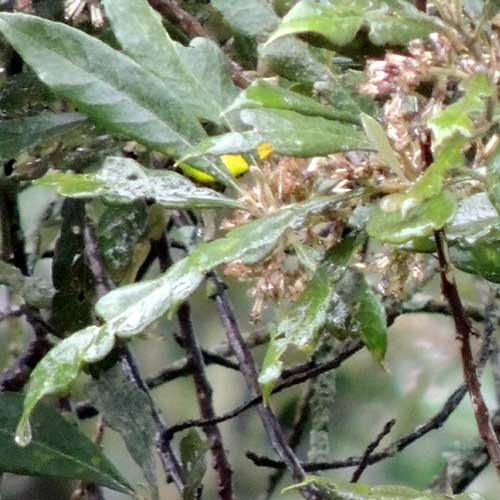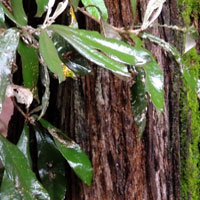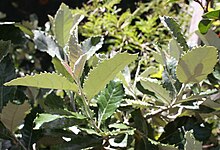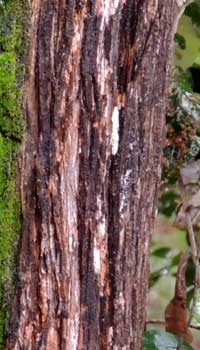Brachylaena huillensis
Brachylaena huillensis is a species of the genus Brachylaena within the sunflower family ( Asteraceae). In the countries of the natural origin of various trivial names used for this species.
- 5.1 wood 5.1.1 Wood Description
- 5.1.2 Specifications for Wood
- 5.1.3 wood properties
- 5.1.4 Durability and use
- 5.1.5 Wood Anatomy
- 7.1 Notes and references
Description
Appearance and leaf
Brachylaena huillensis grows as a shrub or small tree usually reaches stature heights of 7 meters, when conditions are favorable stature heights of 30 to 35 meters in diameter at breast height ( DBH ) of 0.5 up to 0.85 meters. The trunks are often grooved, bent and spannrückig, this makes it difficult to obtain large timber lengths. The trunk is free of branches up to about 8 meters. The gray bark is smooth or rough with cracks. The dark - gray bark is finely longitudinally cracked and peeling off in strips. The bark of the branches is only hairy grayish or brown woolly, verkahlt later, dark - purple and has lenticels and is closely furrowed.
Brachylaena huillensis is evergreen in areas with humid climates and deciduous in dry areas. The alternate, often clustered arranged at the upper ends of the branches leaves are divided into petiole and leaf blade. The petiole is 0.2 to 1.4 inches long. The simple, flat or more or less rolled down the leaf blade is at a length of usually 3 to 10, rarely up to 13 inches and a width of 1 to 3, rarely up to 4 inches narrow elliptic - wrong - lanceolate to wrong - ovate or elliptic to narrowly oblong- elliptic with wedge-shaped Spreitengrund, pointed to rounded upper end which is clearly mucronate. The leaf margin is is usually smooth; He rarely is in wrong - ovate leaf blades strongly spiny- toothed, more or less, particularly towards the blade tip. In the undergrowth, the leaf blades are slightly larger. The glossy matte green leaf surface is initially thin cobweb - like and early glabrous with Netznervatur recognizable. The lower leaf surface is grayish or silvery woolly hairy with raised veins. There are no stipules present.
Inflorescence, flower and fruit
Brachylaena huillensis is dioecious getrenntgeschlechtig ( dioecious ), the inflorescences look significantly different in female and male specimens. In a terminal or pendent, woolly haired, aged men, racemose or nearly spherical total inflorescences the basket- shaped part inflorescences stand together. The flower heads contain only tubular flowers. The male flower heads are at most short-stalked and contain six to seven flowers. Your involucre is bell-shaped with a length of up to 3 millimeters, the bracts increase from outside to inside of egg-shaped with a length of about 1 mm to about 3 mm and elongated. Your creamy white tubular flowers are closely vase-shaped with about 2 millimeters long and more or less recurved Kronzähnen at a length of 3.5 to 5.5 millimeters. The female flower heads are stalked and contain five to six flowers. Your involucre is with a length of up to cylindrical millimeter - inverted - conical, their bracts inward from about 5 millimeters long zoom from the outside at a length of about 1 mm ovoid. Its narrow tubular flowers are 4-6 mm long with erect up to 0.5 mm long Kronzähnen. The woolly hairy bracts shorter than the flowers, hence the genus name Brachylaena, about the " short coat " or "cover " comes means.
The at a length of 3 to 4 mm relatively small achenes are pubescent, almost cylindrical and indistinctly six-to achtrippig. The Pappus consists of several series, with a length of 4 to 5 millimeters, more or less round stem bristles, with their beards are more or less as wide as the length of the bristle axis.
Occurrence and risk
The natural range of Brachylaena huillensis is located in the tropical East Africa and southern Africa. There are deposits in Kenya, Uganda, Tanzania, Angola, Mozambique, Botswana, Zimbabwe, Swaziland and in the South African provinces of KwaZulu -Natal, Limpopo and Mpumalanga.
In low to medium altitudes Brachylaena huillensis occurs. Brachylaena huillensis thrives in different forest types from Highland semi evergreen forest to the coastal dry forest or thicket. Locally it is common in coastal and dune forests and inland to deciduous forest edges or forests in gullies. There are sites on granite or quartzite outcrops. In Kenya it grows in evergreen forests flooded with tree trunks. In the southern and western Zimbabwe thrives on rocky sites of granite outcrops.
Particularly in Kenya and Tanzania carried strong industrial logging and Brachylaena huillensis is one of the most popular woods. Increased use in Mozambique will lead to danger. Populations in South Africa are safe and some stocks are in protected areas. Dense populations have been reported from the northern parts of the Kruger National Park. In the Red List of endangered species in the IUCN in 1998 Brachylaena huillensis as " near threatened " = " low risk" evaluated according to CITES not met Brachylaena huillensis the criteria for Appendix I. For an assessment according to Annex II is not the data are sufficient.
Taxonomy
The first description of Brachylaena huillensis was made in 1902 by Karl August Otto Hoffmann in Botanical yearbooks for systematics, plant history and geography of plants, vol 32, p 149 The epithet huillensis refers to the place name Huilla in Angola. Synonyms of Brachylaena huillensis O.Hoffm. are Brachylaena hutchinsii Hutch. and Tarchonanthus camphoratus sensu Hiern.
Trivial names
For Brachylaena huillensis are many, some tribal language trivial / and trade names. So are the names laeveldvaalbos ( Afrikaans ), low veld brachyleana, low veld silver oak, silver oak (English), mkalambaki, mkarambati, muhugu used muhuhu and mvumo ( Swahili) depending on the area.
Use
From Brachylaena huillensis essential oils are obtained, which are used as a substitute for sandalwood oil.
Wood
Wood Description
The freshly cut heartwood is of hellgelborangener to olivgrünbrauner color. Under the influence of air, the wood will darken to a yellowish brown, slightly greenish color. The sapwood is clearly different from the heartwood. The smell of Brachylaena huillensis is aromatic and similar to that of the sandalwood tree ( Santalum album).
Specifications for Wood
The average dry weight is 930 kg/m3. The grain direction is wechseldrehwüchsig. A curled or warped maser image is possible.
Wood properties
The wood of Brachylaena huillensis is hard and very resistant to abrasion and impact resistant. It shows a high compressive strength, and it is little impact and average bending. The suitability for steam bending is described as middling. Because of the relatively high density blunt tools moderately quickly and saw blades tend to become resinous. The cutting angle when planing should be reduced. Brachylaena huillensis can drechseln good, stain, varnish and polish. Bondings are difficult and when nailing should be pre-drilled. The wood should be dried slowly to avoid cracks, where surface and brain cracks are typical drying defects.
Shelf life and use
The heartwood is moderately resistant to termites and piddock. The wood is resistant to rot. A treatment with wood preservatives is described as very difficult. Brachylaena huillensis is used as resilient flooring, carving and turning wood, pavement bridges, railway sleepers, furniture and heavy construction projects. The use as a fuel will be described.
Wood anatomy
The vessels are arranged diffuse-porous. The Intervessel pits are alternate and have a vertical diameter of 2 to 3 microns. There are numerous tracheids and thick-walled fibers with Fasertüpfeln. The Rays are almost exclusively uniseriate, consisting of a cell type that before. Rarely, there are also double-breasted rays per se. There are found neither Intercellular still crystals.
Health risks
As a health risk in dealing with Brachylaena huillensis dermatitis is displayed.
Swell
- G. V. Pope: Compositae. In: Flora Zambesiaca, Volume 6, 1992: Brachylaena huillensis O. Hoffm. - Full-text online.









